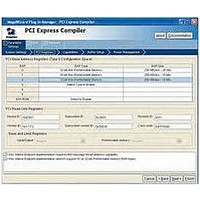IP-AGX-PCIE/4 Altera, IP-AGX-PCIE/4 Datasheet - Page 142

IP-AGX-PCIE/4
Manufacturer Part Number
IP-AGX-PCIE/4
Description
IP CORE - PCI Express X1 And X4 Lanes For Arria GX
Manufacturer
Altera
Datasheet
1.IP-AGX-PCIE1.pdf
(362 pages)
Specifications of IP-AGX-PCIE/4
Software Application
IP CORE, Interface And Protocols, PCI
Supported Families
Arria GX, Cyclone II, HardCopy II, Stratix II
Core Architecture
FPGA
Core Sub-architecture
Arria, Cyclone, Stratix
Rohs Compliant
NA
Lead Free Status / RoHS Status
na
- Current page: 142 of 362
- Download datasheet (7Mb)
5–58
Table 5–33. PIPE Interface Signals (Part 2 of 2)
Test Signals
PCI Express Compiler User Guide
phystatus<n>_ext
rxelecidle<n>_ext
rxstatus<n>_ext[2:0]
pipe_rstn
pipe_txclk
rate_ext
Note to
(1) where <n> is the lane number ranging from 0-7
(2) For variants that use the internal transceiver, these signals are for simulation only. For Quartus II software compilation, these pipe signals can
be left floating.
Table
Signal SOPC Builder
5–33:
c
(1) (2)
(1) (2)
The test_in and test_out busses provide run-time control and monitoring of the
internal state of the IP cores.
implementation.
Altera recommends that you use the test_out and test_in signals for debug or non-
critical status monitoring purposes such as LED displays of PCIe link status. They
should not be used for design function purposes. Use of these signals will make it
more difficult to close timing on the design. The signals have not been rigorously
verified and will not function as documented in some corner cases.
The debug signals provided on test_out depend on the setting of test_in[11:8].
provides the encoding for test_in.
Table 5–34. Decoding of test_in[11:8]
test_in[11:8] Value
4’b0011
All other values
(1) (2)
I/O
O
O
O
I
I
I
Signal Group
PIPE Interface Signals
Reserved
PHY status <n>. This signal communicates completion of several PHY
requests.
Receive electrical idle <n>. This signal forces the receive output to
electrical idle.
Receive status <n>. This signal encodes receive status and error codes
for the receive data stream and receiver detection.
Asynchronous reset to external PHY. This signal is tied high and expects
a pull-down resistor on the board. During FPGA configuration, the pull-
down resistor resets the PHY and after that the FPGA drives the PHY out
of reset. This signal is only on IP cores configured for the external PHY.
Transmit datapath clock to external PHY. This clock is derived from
refclk and it provides the source synchronous clock for the transmit
data of the PHY.
This signal is available for simulation purposes only in the hard IP
implementation.
When asserted, indicates the interface is operating at the 5.0 Gbps rate.
Table 5–35
describes the test signals for the hard IP
Description
December 2010 Altera Corporation
Chapter 5: IP Core Interfaces
Test Signals
Related parts for IP-AGX-PCIE/4
Image
Part Number
Description
Manufacturer
Datasheet
Request
R

Part Number:
Description:
IP CORE - X1 Lane PCI Express For Arria GX
Manufacturer:
Altera
Datasheet:

Part Number:
Description:
CYCLONE II STARTER KIT EP2C20N
Manufacturer:
Altera
Datasheet:

Part Number:
Description:
CPLD, EP610 Family, ECMOS Process, 300 Gates, 16 Macro Cells, 16 Reg., 16 User I/Os, 5V Supply, 35 Speed Grade, 24DIP
Manufacturer:
Altera Corporation
Datasheet:

Part Number:
Description:
CPLD, EP610 Family, ECMOS Process, 300 Gates, 16 Macro Cells, 16 Reg., 16 User I/Os, 5V Supply, 15 Speed Grade, 24DIP
Manufacturer:
Altera Corporation
Datasheet:

Part Number:
Description:
Manufacturer:
Altera Corporation
Datasheet:

Part Number:
Description:
CPLD, EP610 Family, ECMOS Process, 300 Gates, 16 Macro Cells, 16 Reg., 16 User I/Os, 5V Supply, 30 Speed Grade, 24DIP
Manufacturer:
Altera Corporation
Datasheet:

Part Number:
Description:
High-performance, low-power erasable programmable logic devices with 8 macrocells, 10ns
Manufacturer:
Altera Corporation
Datasheet:

Part Number:
Description:
High-performance, low-power erasable programmable logic devices with 8 macrocells, 7ns
Manufacturer:
Altera Corporation
Datasheet:

Part Number:
Description:
Classic EPLD
Manufacturer:
Altera Corporation
Datasheet:

Part Number:
Description:
High-performance, low-power erasable programmable logic devices with 8 macrocells, 10ns
Manufacturer:
Altera Corporation
Datasheet:

Part Number:
Description:
Manufacturer:
Altera Corporation
Datasheet:

Part Number:
Description:
Manufacturer:
Altera Corporation
Datasheet:

Part Number:
Description:
Manufacturer:
Altera Corporation
Datasheet:











